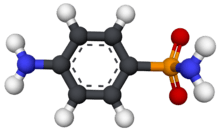Sulfanilamide
 | |
 | |
| Clinical data | |
|---|---|
| AHFS/Drugs.com | Consumer Drug Information |
| ATC code | |
| Identifiers | |
| |
| CAS Number | |
| PubChem CID | |
| DrugBank | |
| ChemSpider | |
| UNII | |
| KEGG | |
| ChEBI | |
| ChEMBL | |
| NIAID ChemDB | |
| ECHA InfoCard | 100.000.513 |
| Chemical and physical data | |
| Formula | C6H8N2O2S |
| Molar mass | 172.20 g/mol |
| 3D model (JSmol) | |
| Density | 1.08 g/cm3 |
| Melting point | 165 °C (329 °F) |
| |
| |
| (verify) | |
Sulfanilamide (also spelled sulphanilamide) is a sulfonamide antibacterial. Chemically, it is an organic compound consisting of an aniline derivatized with a sulfonamide group.[1] Powdered sulfanilamide was used by the Allies in World War II to reduce infection rates and contributed to a dramatic reduction in mortality rates compared to previous wars.[2][3] Modern antibiotics have supplanted sulfanilamide on the battlefield; however, sulfanilamide remains in use for treatment of vaginal yeast infections.[4]
The term "sulfanilamides" is also used to describe a family of molecules containing these functional groups. Examples include:
Mechanism of action
As a sulfonamide antibiotic, sulfanilamide functions by competitively inhibiting (i.e., by acting as a substrate analogue) enzymatic reactions involving para-aminobenzoic acid (PABA).[5] PABA is needed in enzymatic reactions that produce folic acid, which acts as a coenzyme in the synthesis of purines and pyrimidines. Mammals do not synthesize their own folic acid so are unaffected by PABA inhibitors, which selectively kill bacteria.
History
Sulfanilamide was first prepared in 1908 by the Austrian chemist Paul Josef Jakob Gelmo (1879–1961)[6] as part of his dissertation for a doctoral degree from the Technische Hochsschule of Vienna, Austria.[7] It was patented in 1909.[8]
Gerhard Domagk, who directed the testing of the prodrug Prontosil in 1935,[9] and Jacques and Thérèse Tréfouël, who along with Federico Nitti and Daniel Bovet in the laboratory of Ernest Fourneau at the Pasteur Institute, determined sulfanilamide as the active form,[10] are generally credited with the discovery of sulfanilamide as a chemotherapeutic agent. Domagk was awarded the Nobel Prize for his work.[11]
See also
External links
- Sulfanilamides at the US National Library of Medicine Medical Subject Headings (MeSH)
References
- ↑ Actor, P.; Chow, A. W.; Dutko, F. J.; McKinlay, M. A. (2005), "Chemotherapeutics", Ullmann's Encyclopedia of Industrial Chemistry, Weinheim: Wiley-VCH, doi:10.1002/14356007.a06_173
- ↑ http://www.mtaofnj.org/content/WWII%20Combat%20Medic%20-%20Dave%20Steinert/wwii.htm#The%20Use%20of%20Sulfanilamide%20in%20World%20War%20II
- ↑ http://www.med-dept.com/sulfa.php
- ↑ http://pubchem.ncbi.nlm.nih.gov/summary/summary.cgi?cid=5333
- ↑ Michael Kent, Advanced Biology, Oxford University Press, 2000, p. 46 ISBN 978-0-19-914195-1
- ↑ Biography of Paul Gelmo: Encyclopedia.com.
- ↑ Paul Gelmo (May 14, 1908) "Über Sulfamide der p-Amidobenzolsulfonsäure," Journal für Praktische Chemie, 77 : 369-382.
- ↑ On May 18, 1909, Deutsches Reich Patentschrift number 226,239 for sulfanilamide was awarded to Heinrich Hörlein of the Bayer corporation.
- ↑ G. Domagk, "Ein Beitrag zur Chemotherapie der bakteriellen Infektionen", Deutsche Medizinische Wochenschrift, 61, feb. 15, 1935, p. 250.
- ↑ J. et T. Tréfouël, F. Nitti and D. Bovet, "Activité du p-aminophénylsulfamide sur l’infection streptococcique expérimentale de la souris et du lapin", C. R. Soc. Biol., 120, nov. 23, 1935, p. 756.
- ↑ (in French) Daniel Bovet, "Les étapes de la découverte de la sulfamidochrysoïdine dans les laboratoires de recherche de la firme Bayer à Wuppertal-Elberfeld (1927-1932)", in Une chimie qui guérit : Histoire de la découverte des sulfamides, Coll. "Médecine et Société", Payot, Paris, 1988, p. 307.